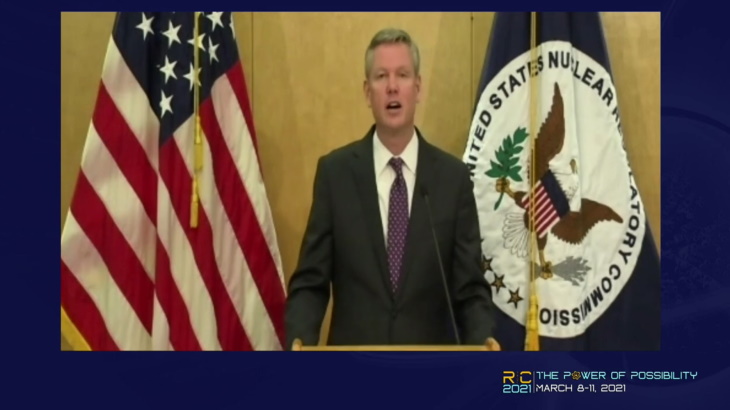According to his NRC biography, Hanson's more than two decades of government and private-sector experience in nuclear energy fields include service as a staff member on the Senate Appropriations Committee, overseeing civilian and national security nuclear programmes; as a senior advisor in the Department of Energy's Office of Nuclear Energy; and also oversight of nuclear and environmental cleanup programmes in the Office of the Chief Financial Officer.
Hanson told RIC delegates, "I grew up around nuclear." The Palisades nuclear power plant, in Michigan, was about 10 miles - 16km - from his family home, and the single-unit PWR plant played a key role in the local economy. "So I had an interest in nuclear early on - as a source of electricity, sure - and as a source of good-paying jobs," he said.
Turning to his approach to his tenure as the head of the US nuclear regulator, Hanson used the image of a "triangle" of risk-informed regulation, transformation, diversity inclusion, underpinned by three pillars: regulatory independence, data and people.
Becoming a "more modern, risk-informed regulator" remains a key goal for the NRC, Hanson said. "Reasonable assurance of adequate protection is still the standard to meet." The concept of risk-informed regulation could be broken down into three questions he said. "What do we know? How do we know it - what is the basis of the knowledge? And what difference does it make - are we focused on gathering data and better understanding things that are actually important to safety?"
"I know it's more complicated than this," he said, adding that defence-in-depth should remain a key tool to ensure adequate regulatory protection.
The NRC needs to ensure the safety of the current nuclear fleet and uses, as well as new technologies. It must do this, not by confining itself to historical frameworks, but by identifying and focusing on the most risk-significant components and systems, he said.
The second point on the triangle - transformation - is the NRC's ongoing effort to rethink its outward and inward facing processes through technology and employee engagement, he said. This is interlinked with the third point, diversity and inclusion, with risk-informed regulation relying on diverse staff and backgrounds to be effective.
NRC's transformation must keep its safety mission "front and centre"; pursue innovation but without implementing "change for change's sake", reap returns on investments, and more fully explore efforts in the regulatory arena, especially for new reactor technologies.
"The [NRC] is working hard to meet the challenges presented by a rapidly changing and innovating nuclear industry … Transforming our business processes is also a great way to transform our regulatory processes," he said, giving the example of NRC's Mission Analytics Portal, which integrates data from different sources to give staff better tools to manage licensing, oversight and support activities. "In the future, we should be able to use these same tools to mine data from available sources - such as inspection reports - [to] provide insights we wouldn't otherwise see, leading to more transparent and informed decision-making," he said.
Pillars of support
Turning to the first of the three pillars supporting the triangle - regulatory independence, Hanson said public trust is essential for future of nuclear power. As well as trusting the regulator to be independent and impartial, the public must also be able to trust industry to operate safely.
Independence should not mean isolation, he said, adding that work with others - nationally and internationally - is important for the safe use of nuclear energy in the future. "It's important to build trust in science, and increased reliance on operational experience," he said, but recognised that "traditional" approaches to safety are easier to communicate than those that are risk-informed and performance-based. "To that end, as we move toward more risk-informed approaches, to maintain public confidence we must ensure transparency and clear communication in our licensing review and other activities," he said.
Hanson expressed his hope that drawing on the NRC's "veritable treasure trove" of data from over 50 years of nuclear plant operation would ensure that is regulation would be based on "realism". He also recognised the importance of using risk-informed performance-based approaches as the NRC moves forward with the regulation of advanced reactors.
"With more reliance on risk assessment, it is critical that underlying assumptions and computer models are validated with real-world data wherever possible. Demonstrating - not just asserting - the performance of inherent safety features will be key to effective and efficient reviews," he said. Risk-informed decision making "means we must characterise uncertainty" and must "to the maximum extent possible" be grounded in the "real world," he said.
People remain the NRC's greatest asset, he said, with a staff of over 2700 career professionals. However, some 40% of NRC employees will become eligible for retirement in next five years - and the agency is focusing on recruitment and retention programmes to meet the challenge of building and maintaining an agile workforce capable of tackling future challenges.
"We must always be dedicated to ensuring our institutions live up to our ideals … maintaining public trust through independence, transparency, predictability and a commitment to reasonable assurance of adequate protection based on sound data, analysed by a diverse workforce," he said.





_18570.jpg)
_16159.jpg)
_49205.jpg)
_18938.jpg)





